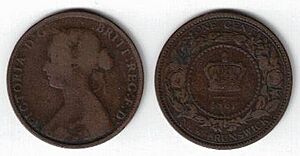New Brunswick dollar facts for kids
Quick facts for kids New Brunswick dollar |
|
|---|---|
| User(s) | |
| Subunit | |
| 1⁄100 | cent |
| Symbol | $ |
| Coins | 1⁄2, 1, 5, 10, 20 cents |
| Banknotes | 1, 2, 3, 4, 5, 8, 10, 20, 50, 100 dollars |
The New Brunswick dollar was the money used in New Brunswick for a short time. It was in circulation from 1860 to 1867. Before this, people in New Brunswick used the New Brunswick pound.
The New Brunswick dollar replaced the pound. Four dollars were worth one pound. This new dollar was also equal in value to the Canadian dollar at the time. When New Brunswick joined the Canadian Confederation (which is like Canada becoming a country), the New Brunswick dollar was replaced by the Canadian dollar. They were exchanged one for one.
Coins of New Brunswick
Coins for the New Brunswick dollar were made between 1861 and 1864. They came in different values: half a cent, 1 cent, 5 cents, 10 cents, and 20 cents.
The half-cent and 1-cent coins were made from bronze. The other coins (5, 10, and 20 cents) were made from silver. The half-cent coin was actually made by mistake! New Brunswick did not really need this coin value. Because of this, most of these half-cent coins were melted down. This makes the surviving half-cent pieces quite rare today.
Banknotes of New Brunswick
Four special banks in New Brunswick printed their own paper money, called banknotes. These banks were the Bank of New Brunswick, the Central Bank of New Brunswick, the Commercial Bank of New Brunswick, and the People's Bank of New Brunswick.
These banknotes came in many different values. You could find notes for 1, 2, 3, 4, 5, 8, 10, 20, 50, and even 100 dollars. The notes from the Commercial Bank also showed their value in pounds and shillings, which was the old money system. Some of these banks, like the Bank of New Brunswick, continued to print notes even after New Brunswick joined Canada.
See also


